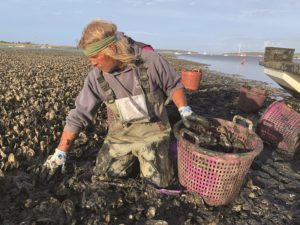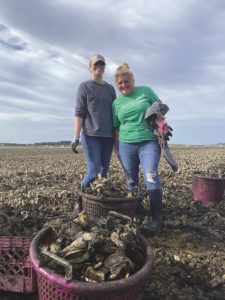WELLFLEET — When the dense sea lettuce in Chipman’s Cove cleared up a few weeks ago, Nancy Civetta and Johnny “Clam” Mankevetch of the Wellfleet Shellfish Dept. strolled through at low tide to judge how best to prepare for the harbor dredging set to begin on Oct. 1. Scanning the bottom, they saw an oyster bonanza.

“It’s just a phenomenal oyster bar,” Civetta, the town’s shellfish constable, said at the Shellfish Advisory Board meeting last Monday.
Civetta and Mankevetch, the assistant constable, knew there was a problem: the dredging would churn up loads of sediment that could potentially choke oysters. In response, the department, along with more than a dozen volunteers, spent the past week scooping up clumps of oysters by hand, dumping them into baskets, and ferrying the crop out of harm’s way. And on Thursday, Sept. 30, they will open the outer bar of Chipman’s Cove to commercial shellfishing — a month ahead of schedule.
“This is a tremendous crop,” Johnny Clam told the Independent. “You better get ’em before the dredge gets ’em.”
Achy Backbreak-y Days
Volunteers arrived on Saturday before dawn, waiting for the tide to uncover the beds. That’s when the relaying begins, work that involves “bending, kneeling, mud-wiping, hauling, lifting, shoveling, and raking,” said David Aronow, a recreational shellfisherman who volunteers whenever the shellfish dept. needs an extra pair of hands.
Oyster shells can slice through gloves, and muscle aches are a given. “Fighting the need to pee,” Aronow added, can be quite trying, too. After loading up the barge, the team took a breather, waiting for the water to rise just enough to float the boat.
Mankevetch took the crew inshore, and volunteers pushed the bushels overboard, out of harm’s way. This, too, is backbreaking labor. Mankevetch watched as volunteers took it on. “Unfortunately for them, but fortunately for me,” he said, “someone has to steer the ship!”
“This was what we signed up for,” Aronow said. “I greatly enjoy being near, on, and in the water in all seasons.”
Another bonus: it’s porgy season. “What a joy to pause from pulling oysters to watch bands of shimmering silver fish popping out of the water,” Aronow said. “And then, to notice seals among the moored boats, eager for the buffet. Several times, they jumped almost entirely out of the water to gobble up fish.” He declared the scene worth a morning on the oyster relay.
Near Term Risks
In the long run, dredging the cove is expected to improve the health of oysters. “A deeper channel will create more water flow, which might pull silt away from the beds,” Civetta said.

“Dredging actually has to happen,” she added. “It’s in our regulations.” But clearing the silt will come with a short-term cost of “kicking up a gratuitous amount of sediment,” said Mankevetch. Through “truck-to-truck parking lot” chatter, he received multiple requests from concerned fishermen, urging him to move the crop.
In 2010, the Western Dredging Association, a nonprofit technical organization devoted to the field, reviewed decades of research documenting the effects of nearby dredging on oyster beds. Sediment loads from dredging can deprive oyster larvae, or spat, of the “clean, hard bottom” needed for attachment, they found. For both juvenile and adult oysters, suspended particles can interfere with filter-feeding, harming growth and reproduction.
Unlike clams, which are often found buried in the intertidal zone, oysters must live above the sediment, said Barbara Brennessel, a biologist who lives in Wellfleet. “If the sediment were to cover the oysters, they’d be lost,” she added.
The direct consequences of this year’s harbor dredging on the Chipman’s Cove crop is hard to predict; the oyster relay is a precautionary measure. “You know,” Mankevetch said, “I’d love someone to say, ‘Boy, that was a waste of time. Everything lived.’ ”
A Spawning Sanctuary
Why Chipman’s Cove teems with oysters is a mystery. “It could be related to the wind and currents,” Civetta said, “but there’s a confluence of characteristics that lets the place catch a lot of spat.”
For this reason, while water quality in Chipman’s Cove consistently meets state standards, Wellfleet has pursued a seasonal closure strategy to support a spawning sanctuary during the summer. The zone usually reopens on the last Sunday of October for commercial and recreational shellfishing.

But with dredging season looming, Civetta told the Shellfish Advisory Board on Monday that the past week’s laborious relay effort amounted to only “a drop in the bucket.” Bushel upon bushel remain on the outer bar, so Civetta requested permission to open Chipman’s Cove to commercial harvesting in order to get the oysters “out of harm’s way.”
On Sept. 27, the advisory board voted unanimously to support Civetta’s request, and on Sept. 28, the select board granted its approval. Chipman’s Cove will be open a month earlier than usual for commercial harvesting, starting Sept. 30.
On that day, the volunteers who aided the relay effort will also be invited to grab a basket of oysters “as a thank you for their commitment to the fishery,” Civetta said. Other recreational shellfishermen will be able to splash into the bonanza starting on Halloween.
If opening to commercial harvest does not make enough of a dent in the oysters on the bar, the shellfish dept. is considering hiring an oyster dragger to collect the rest of the crop. A dragger can do a more complete job, Civetta said, but that would come with a tradeoff: by pulling up everything, the machine strips away reef habitat for future oyster beds. “There’s always a balance of harms,” Civetta said.



